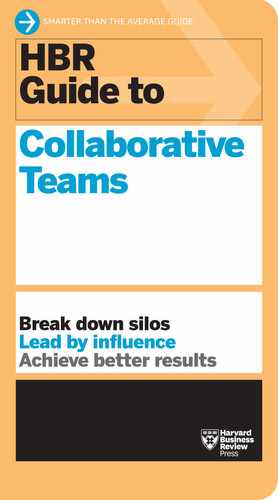Break down the barriers to effective collaboration. For cross-functional projects to work, you need to bring together diverse ideas and resources from across your organization. But office politics, conflicting objectives, and lack of clear authority can get in the way. The HBR Guide to Collaborative Teams provides practical tips and advice to help you collaborate more effectively. Whether you're leading your own direct reports or building a talented group from disparate parts of your organization, you'll discover how to align others' goals and skills so you can solve problems as a team and deliver great results. You'll learn to: Arm yourself with the advice you need to succeed on the job, with the most trusted brand in business. Packed with how-to essentials from leading experts, the HBR Guides provide smart answers to your most pressing work challenges.
Table of Contents
- Cover
- Series Page
- Title Page
- Copyright
- What You’ll Learn
- Contents
- Introduction: Why Collaboration Is So Hard: To work together well, we need to embrace our differences.
- Section One: Making Yourself Collaboration-Ready
- Section Two: Building the Team
- 4. Great Teams Are About Personalities, Not Just Skills: Here’s how to get the right mix.
- 5. Six Ways to Convince Someone to Collaborate with You: Think about what you can offer them in return.
- 6. Making Star Teams Out of Star Players: There’s a right way and a wrong way to organize them.
- 7. Ensuring Agile Teams Can Work Together: Nurturing internal networks can lead to better outcomes.
- Section Three: Being Productive as a Team
- 8. High-Performing Teams Need Psychological Safety: Here’s how to create it.
- 9. The Best Teams Have Clearly Defined Roles: Fuzzy responsibilities are bad for collaboration.
- 10. Helping Teams with Different Subcultures to Collaborate: Every company has many cultures.
- 11. Get Your Team to Do What It Says It’s Going to Do: “If-then planning” is the key.
- 12. Don’t Let Teamwork Get in the Way of Agility: Each project stage needs the right amount of teamwork.
- 13. How to Motivate Your Problem People: The most intractable people take up the most time and energy.
- Section Four: Communicating and Making Decisions
- 14. Cracking the Code of Sustained Collaboration: Six tools for training people to work together better.
- 15. Seven Strategies for Better Group Decision Making: Keep the group small and diverse.
- 16. A Good Meeting Needs a Clear Decision-Making Process: Before you start, agree on how it will end.
- 17. Four Tips for Effective Virtual Collaboration: Be strategic about meetings and communication.
- 18. If Your Team Agrees on Everything, Working Together Is Pointless: Constructive conflict is good for creativity.
- Section Five: Navigating Conflicts and Power Struggles
- 19. How to Permanently Resolve Cross-Department Rivalries: Four questions to start getting on the same page.
- 20. Navigating a Turf War at Work: Check your mindset, and focus on the larger goal.
- 21. How to Handle a Disagreement on Your Team: Be a mediator, not a boss.
- 22. Collaborating with People You Don’t Like: You can still have a productive relationship.
- Index
